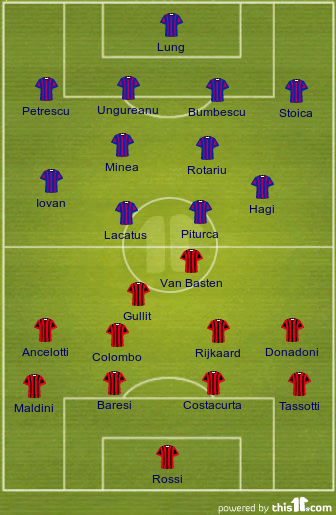From the era of Catenaccio onwards, Italian football had been founded on the Libero. Manmarking and the use of a sweeper had been the hallmarks of Italian sides for over 2 decades. The 1970 finalists had used Cera there, while the 1982 World Cup winners had the legendary Gaetano Scirea as their Libero. In the late 1980s and early 1990s that changed.
As with so many of the tactical innovators, Arrigo Sacchi did not inherit a Milan side in good health. The two time European Champions had fallen on hard times in the 1980s until media mogul Silvio Berlusconi arrived to rescue the club. His appointment of Sacchi, a man who had never played professional football, was not the most promising, but it turned out to be an inspired decision.
The easy option for Sacchi when arriving at Milan would have been to follow the traditional path and play with a sweeper, especially given that in Franco Baresi he already had one of the best in the world. Instead, he chose to play with a flat back four as was commonly used in England. Baresi was comfortable on the ball, and was still able to bring the ball out of defence from a role within the backline but he sat no deeper than his partners in the Milan defence. Having signed Marco Van Basten from Ajax and Ruud Gullit from PSV Eindhoven at great expense, Milan were well set up front. However, the addition of fellow Dutchman, Frank Rijkaard, gave the side greater solidity and allowed them to introduce the pressing game used by Ajax, and which had been utilised to great effect by Liverpool. In central midfield Rijkaard was joined by Carlo Ancelotti, and both had the energy to press the opposition and force them into errors.
 |
| Milan (below) v. Steaua Bucharest, 1989 |
If Sacchi’s team showed the rest of Italy the use of the flat back four and had undermined the pre-eminence of the sweeper, a rule change helped to kill it dead. Just as the change to the offside law in the 1920s had forced the introduction of the third back and arguably made the game more defensive, the back-pass rule of 1992, intended to stop teams killing time and stifling play, had a similar unintended consequence. In the past sweepers had been able to bring the ball out of defence, safe in the knowledge that if under pressure they could just pass the ball back to their keeper. By prohibiting keepers from picking the ball up from back-passes, few defenders were now so bold as to attack from the back, as they knew that any mistake would provide their opponents with a goalscoring opportunity.
The result of the rule was that keepers were now reluctant to start attacks from the back and more inclined to hoof the ball out from hand, thus bypassing the defence. While some old-school sweepers persevered, such as Danny Blind and Matthias Sammer, the increasing trend in the 90s and beyond was for a flat back four with two stoppers in central defence. The era of ball playing sweepers in the mould of Beckenbauer or Scirea was over and with it one of the most elegant roles in the modern game.
A notable exception to the spread of the flat back four were Italy’s 2000 European Championship finalists who played a back three of Nesta, Cannavaro and Iuliano, with wing-backs Maldini and Pessotto outside them. The final hurrah for the central back three was Brazil’s 2002 World Cup winning team who used the system to great effect. Yet neither of these sides used a sweeper within the back three and by the end of the decade the flat back four had triumphed as the undisputed king of defensive systems.

5 comments:
Comme, I enjoy reading your entries on tactics like this. If Pirlo had been born 30 years ago, could we safely assume he'd be libero in the classic sense? Which other players around today would likely be ball playing sweepers if born 30 years earlier?
I personally think Pirlo would have been more likely to stay in the trequarista role that he played at the start of his career.
The reason being that for all the elegance that the likes of Beckenbauer, Krol, Scirea etc showed, they were still very capable defenders.
Pirlo's positioning does allow him to intercept quite a few passes and he cuts off passing lines well. However, I'd always feel he'd be vulnerable as the last line of defence that the sweeper is expected to provide.
In terms of who else might play there, I think the likes of Redondo, Carrick, Xabi Alonso would have been well suited to the role.
Thanks! Redondo player during the 1990s, when sweepers were still around, though! But he and/or there men in charge opted not to use him as a sweeper (primarily because at Real they had Hierro I guess).
Also Argentina has no tradition of sweepers. In Argentine football the two key positions have been (since Pippo Rossi in the 40s/50s) the "number 5" that Redondo played and the "enganche" or classical playmaker.
England doesn't have the tradition either (hence questionable over Carrick), but those are the types of players who might have excelled there.
I always wondered why there was no room for sweepers in todays football? WIth ur entry on this post it becomes gut wrenching that this most elegant position world football will never return again becoz of that stupd 1992 back pass rule. I wish fifa could do something abt this stupidity. Anyways a very nice post.
Post a Comment